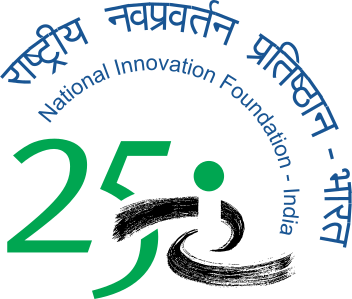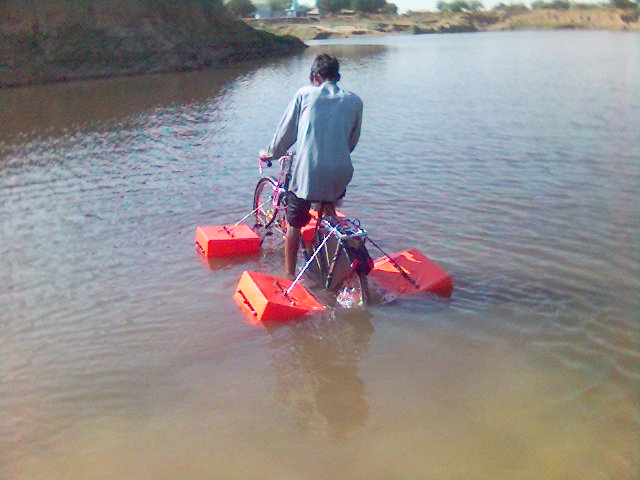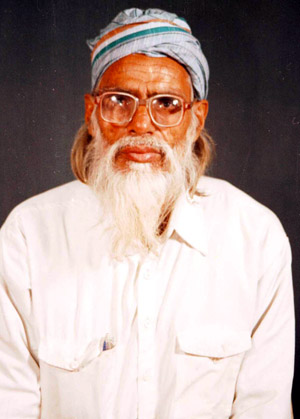The Innovation
The amphibious bicycle comprises a conventional bicycle modified with two extra attachments attached to it that enables it to run on both water and land. The first attachment consists of four rectangular air floats, which support the bicycle while moving in water. These rectangular floats are in two pairs and each pair is attached to the front and rear wheel of the bicycle with a piece on either side of the wheel. These floats can be folded when the bicycle runs on land. These floats are lightweight and hence the cyclist does not feel any extra burden.
The other attachment comprises the fan blades attached in a radial manner on the spokes of the rear wheel. When the cyclist pedals the bicycle in water, the blades attached to the rear wheel also rotate and force the water to be pushed backwards thus enabling the bicycle to move forward. The blades are arranged in such a fashion that it can be driven in the reverse direction as well.
Advantages
The advantages are obvious as people in rural areas need no longer solely depend on the few overcrowded boats for crossing the river. Further, crossing the river can be done at one’s own convenience. As the cycle operates on both land and water, the time and money required for hiring a boat to cross the river and for further transportation on land is saved. A further application could be in amusement parks or children’s parks or for sending provisions to people living around a lake or for removing aquatic weeds or dragging a raft carrying goods, nursery plants etc.
NIF has sanctioned Saidullah a sum of Rs.33, 750 from the Micro Venture Innovation Fund for the prototype development for market research of the Amphibious Bicycle.
Mini Tractor
The mini-tractor comprises a conventional tractor modified in such a manner that it has a clutch-plate free system, uses a dynamometer instead of battery for light and has a hydraulic lifting mechanism for propelling farm implements. An air pressure horn is also used in it. It is easy to handle and costs only Rs.70, 000. Moreover it can be used to transport material. The first model of the tractor was made in 1984 and could be used for ploughing and tilling. It consumed five litres of diesel per hour to run for six hours with a 20 quintal load at a top speed of 18kms/hour. Initially he travelled by this tractor to Muzaffarpur, Raksol.
Key operated Table fan
In 1960, in the context of irregular electricity supply and its increasing cost, Saidullah thought of developing a fan that would work with a key, to provide some relief from the relentless heat during the summer season. The key operated fan is a conventional fan modified in such a way that there is a coiled spring and hand crank-key attached to it. On rotating the hand crank-key, the fan stores potential energy in the coiled spring and uses it to deliver rotational torque. By hand cranking the key for half a minute, the fan rotates for one hour. The cost of this fan is Rs.1000. Its advantages lie in the fact that there is no running cost for the fan as electricity is not required. This is especially a boon in the rural areas where electricity is scarce, and will be useful during the summer.
Fodder cutter operated centrifugal pump
The centrifugal pump consists of a flywheel (fodder cutter wheel) attached to the conventional centrifugal pump. The diameter of the flywheel is larger than the impeller. A handle is provided on the flywheel to rotate it so that the effort required is minimal. When the handle on the flywheel is rotated by hand, the impeller of the centrifugal pump also rotates and the pump delivers water at ground level with a 20 feet suction head and zero delivery head. The discharge capacity is 10,000 litres per hour.
The advantage of the pump is its quality of conserving energy, as neither electricity nor diesel is required. Further, only human power is required to supply water to the farm. The manufacturing cost of the pump is Rs. 3000/-
Spring loaded (shock absorber) bicycle
The spring-loaded bicycle is a modified bicycle with a number of springs attached to it to absorb the shocks on an uneven road. One spring is attached below the seat of the bicycle; two springs are attached in such a way that one end of each is attached to the axis of the front wheel and the other end is attached below the handle. The carrier at the back of the bicycle is also supported with two springs so that the other end of each spring is attached to the axis of the rear wheel. These five springs, by absorbing vibrations from the road, make the bicycle shock-free and provide greater comfort to the cyclist while riding. The springs attached to the rear wheel absorb the shock at the rear wheel thus ensuring a comfortable ride for the person sitting on the rear seat also. The cost of the spring loaded bicycle is Rs. 2500/-.NIF has sanctioned him a sum of Rs.15,000 from the Micro Venture Innovation Fund for the prototype development for market research of this innovation.
Bicycle operated through conserved energy by pedal operation This innovation is a conventional bicycle modified in such a manner that two chain drives used are used instead of one. The pedal of the cycle is attached to a crank, which is further attached to sprocket-1 of the first chain drive; a coiled-spring is attached with sprocket-2 of this first chain drive. On the shaft of sprocket-2 of the first chain drive, sprocket-3 of the second chain drive is mounted, which is further attached to sprocket-4 of the second chain drive through the chain. The rear wheel of this bicycle is mounted on the shaft of sprocket-4 of the second chain drive. While riding the cycle, when the cyclist pedals ten times, the coiled spring is tightened and stores energy in it. After ten times, the cyclist stops pedalling. The stored energy in the coiled spring helps the cycle to move forward for about one kilometre with a speed of 20 km/hr. After covering one kilometre, the coiled spring is unwound. Hence there is no energy stored in it and the cyclist has to repeat the process. This idea originated with a friend’s commenting, “Up to what stage will you drive a cycle, why not purchase a motorcycle?” To this Saidullah replied that he would purchase a motorcycle, but also claimed that he could make his bicycle function like a motorcycle. Saidullah fulfilled the claim he made to his friend, as the speed of his innovated bicycle is higher than that of a conventional one. In addition it requires less effort.
Mini turbine for electric generation
The mini turbine consists of a turbine, that is attached with bucket-blades in a radial manner. The turbine is placed inside the water surface and when the water falls on the inner curved surface of the bucket-blades, it rotates the blade of the turbine. This rotational energy is further transferred to the dynamo that transfers the energy for lighting the bulb. It gives the energy to run two bulbs simultaneously.
The advantages are that it is easy to handle and a low cost alternative. Further, it makes use of a renewable source of energy, flowing water, especially in the context of our looming energy crisis, when every bit counts.
Awards and accolades…
Once he sent a letter to Pt. Jawaharlal Nehru regarding his innovations and invited Panditji to come and see them. Though Panditji received his letters and replied that he would come, he was not able to and sent a letter to Saidullah regretting his inability to visit his place.
Saidullah’s innovations were featured in various newspapers and news channels such as Pratiyogita Darpan, The Times of India, Hindustan, Ankur, Jansatta, Nepal Newspaper and Doordarshan. Many organizations have contacted him including CSIR, CAPART and TIFAC. CAPART contacted him in 1993 regarding his innovative fodder-cutter operated mini water pump. A team from CAPART visited his house and tested this machine in a pond, bore well, and hand pump. They offered him double the amount (Rs. 6000/-) and asked him to develop one machine for CAPART. He asked them to approach him through the proper channels with a written non-disclosure agreement and only then would he manufacture it for them. He was also suspicious of the fact that he was being offered Rs.6000 to manufacture the machine when he had mentioned the cost as Rs.3000.
Technopreneur Promotion Programme (TePP) of the Technology Information and Forecasting and Assessment Council (TIFAC) also wrote to him and sent a cheque of Rs. 25,000/- for the development of the amphibious bicycle. But they stipulated some conditions, which were not acceptable to Saidullah. Saidullah firmly believes that for him to come up with an innovation, his mind must be unfettered and not restricted by any conditions. He continues to keep the cheque with him. On January 26, 1994, Purvi Champaran Collector Mr. Binod awarded him for his various innovations.
Dr. A R Kidwai, governor of Bihar honoured him on January 26, 1995 in Patna with the first prize for tableaux (Jhanki) of his innovations during the Republic Day Parade in Gandhi Maidan, Patna but he is yet to receive any certificate, medal, trophy or award money. In November of the same year, the district collector of Chapra, Bihar honoured him during the Sonepur mela.
A life-long passion for innovation…
Since childhood, Saidullah has had an interest in mechanical things. He was always busy solving problems by putting forward innovative solutions in the form of inventions and in one such attempt even broke all the locks in his house. Initially he worked as a mechanic because of his interest in making things with iron and this has proved invaluable in his efforts to construct the innovations himself. A day on which he doesn’t work with iron is, according to him, a wasted day. Carpentry, masonry, tailoring etc., are also part of his repertoire.
A philosopher, his mind is always occupied with problem-solving, which would benefit families and society and he is always in search of innovative ideas. When he gets an idea his whole face lights up with a smile. Impelled by a deep love for nature, which he believes is God’s gift to man, he has tried to make his innovations as environment-friendly and agriculture-based as possible. On his innovations, he has worked alone apart from occasional help from his family.
The reality of life…
As a mechanic, his income was not sufficient to fulfil his family’s needs. So he is currently engaged in the honey business. Everyday he rides his bicycle for about 30 km to the market to sell honey of Lichi, Cronj, Liptus, Khaisari, and Mustard plants. His monthly income is Rs. 1300/-.
He, however, feels quite disheartened due to a lack of land and money as well as people’s niggling queries regarding his innovations especially regarding the number of items he has sold. Saidullah also comments, “Hamara saman hai agar sahi, to kyon rah gaye wahi ke wahin” which translated means “If my innovations are of good quality, then why am I not successful?” Out of sheer frustration he even broke his fodder cutter operated water pump.
Personal profile
Mohammed Saidullah grew up in a small village called Jatva-Jeneva (Purvi Champaran) of Motihari district, Bihar. His father Shaikh Idris was a farmer and a Congress village leader during the time of Independence. Saidullah has studied up to the tenth standard in Ramsingh Chatuani in Gajpura but could not complete his studies due to personal reasons. He married Noor Jahan in 1960 and has three children - two daughters and a son. He is 60 years old and a devout Muslim and proudly claims that he has only asked for help from Allah and no one else. Self respect and self development are two tenets of his character and he is a very compassionate man who often helps out friends who are in financial difficulties.
His love for his wife is so evident that every innovation of his has been named after her. Thus we have the “Noor bicycle”, the “Noor Rahat” electric power house”, the “Noor water pump” etc. Mohd. Saidullah lives with his daughters in Mathia deah village in Purvi champaran (Motihari). Unfortunately his love for innovations has been at a personal price as his son is estranged from him and is demanding land and money but Saidullah has sold all of his 40 acres of land in pursuit of his innovations and his generosity.
“An inventor’s mind should be free; not bound with conditions”- a belief that has fuelled Mohammad Saidullah’s passion to develop multi-functional products such as the amphibious cycle, the mini tractor, key operated table fan, fodder cutter-operated mini water pump and others. He draws inspiration for his innovations from his experiences in life. His innovations include amphibious bicycle, Mini tractor, Spring loaded cycle, Fodder cutter operated Mini water pump, Key operated Table Fan, Conserved Energy operated bicycle and Mini turbine for electric generation. He has also a designed a magic painting, that shows the picture of eminent leaders like Lal Bahadur Shastri, Pt. Rabindranath Tagore and Subhas Chandra Bose.
Apart from these innovations, Saidullah nurtures two ideas in his mind. One is to develop a mini electric powerhouse which he has already named “Noor rahat”. This would produce electricity to operate at least two fans and two bulbs. The cost of developing this would be Rs.50, 000/-. The second idea is to develop a helicopter, which would cost Rs. 25 lakhs. Most of his innovations have the name ‘noor’ in them. This is to revere the memory of his late wife whose name was Noor. This inspires him to innovate over and over again.
The genesis
The state of Bihar is prone to floods. In 1975, there was a big flood in Champaran which lasted for about three weeks and Saidullah had to cross the river to get provisions. To cross the river he used a boat and in the city he used a bicycle.
Then it struck him that if he could make the bicycle float on water as well as move on land it would save money. Within three days, he had developed such a bicycle. This amphibious bicycle is also known as “NOOR Bicycle”. Using this cycle he crossed the Ganga from Pahelaghat to Mahendrughat (Patna). Initially he spent Rs.6000/- on the development of the floating bicycle. But now he says he will be able to build it at a cost of Rs. 3000/- .








